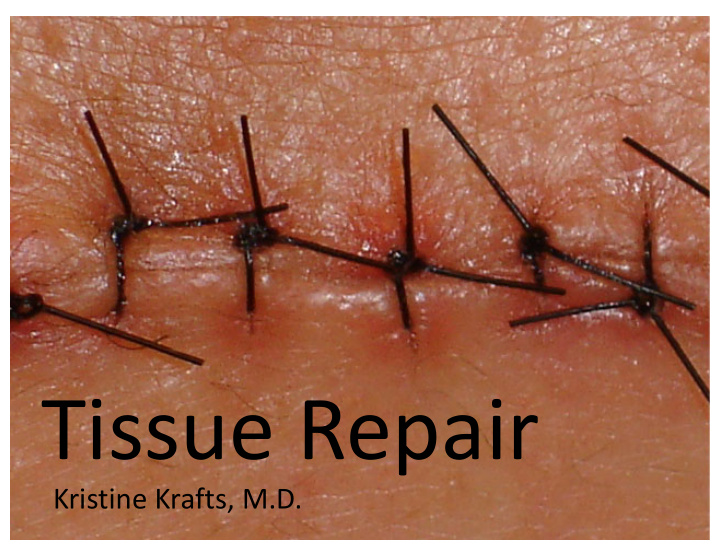



Tissue Repair Kristine Krafts, M.D.
Tissue Repair Lecture Objectives • Define tissue repair, regeneration, and scarring. • Explain the difference between labile, stable, and permanent tissues, and give examples of each. • Explain the importance of stem cells in regeneration, and list the two types of tissues in which regeneration can occur. • Outline the main steps involved in scarring, and be sure you know what granulation tissue is.
Tissue Repair Lecture Objectives • Describe what you’d need to know in order to predict whether a wound will heal by regeneration or scarring. • Compare and contrast first-intention and second-intention healing, and know the rough timeline for first-intention healing of small wounds. • Describe in general how strong a wound is at suture removal, and explain how that wound strength changes over time. • Explain how the wound healing process is abnormal in keloid scars and proud flesh.
Tissue Repair Lecture Outline • Introduction and definitions • Three types of tissues • Repair by regeneration • Repair by scarring • A couple things about skin wounds • Abnormal wound healing
Tissue Repair Lecture Outline • Introduction and definitions
Tissue Repair Tissue repair is defined as the restoration of tissue architecture and function after an injury. It involves two processes: • Regeneration (full restoration to normal) • Connective tissue deposition (scarring)
Tissue Repair Lecture Outline • Introduction and definitions • Three types of tissues
Three Types of Tissues Labile (continuously proliferating) tissues • Composed of cells that are constantly being lost and replaced • Replacement comes from stem cells and also from proliferation of some mature cells • Can easily regenerate after injury • Examples: skin, bone marrow, GI epithelium
Stem cells in GI epithelium
Three Types of Tissues Labile tissues Stable (quiescent) tissues • Composed of cells that have a minimal ability to proliferate • Can undergo some regeneration after injury • Examples: liver, kidney, pancreas
Three Types of Tissues Labile tissues Stable tissues Permanent tissues • Composed of cells that cannot proliferate • Cannot regenerate in response to injury • Injury always results in scarring • Examples: brain, heart
Tissue Repair Lecture Outline • Introduction and definitions • Three types of tissues • Repair by regeneration
Regeneration • Occurs all the time in labile tissues! • Occurs in limited form in stable tissues • Remove one kidney: the other one undergoes hypertrophy and hyperplasia • Remove half of the liver: it will grow back • Doesn’t occur at all in permanent tissues.
Liver right lobe before to be resection resected left lobe Liver now 1 week enlarged after resection
Tissue Repair Lecture Outline • Introduction and definitions • Three types of tissues • Repair by regeneration • Repair by scarring
Scarring • If full regeneration isn’t possible, then you need to make a scar. • What determines whether regeneration is possible? • Type of tissue • Extent of extracellular matrix damage • Scarring involves creating new blood vessels (angiogenesis), laying down collagen (which is made by fibroblasts), and eventually remodeling the collagen so the scar is just right.
1. New blood vessels 2. Fibroblasts 3. Extracellular matrix collagen
Scarring Summary: 1. Make granulation tissue 2. Turn it into a chunk of collagen
Fibroblasts New blood vessels Collagen Extracellular matrix Granulation tissue
Blood vessels Collagen Scar
Q. Is “ granulation tissue ” the same thing as “ granuloma ” ?
Q. Is “ granulation tissue ” the same thing as “ granuloma ” ? A. No!
Granuloma
Tissue Repair Lecture Outline • Introduction and definitions • Three types of tissues • Repair by regeneration • Repair by scarring • A couple things about skin wounds
Skin Wounds: Two Types of Healing Second intention healing First intention healing
First Intention Healing Second Intention Healing Small wounds that close easily Large open wounds Regeneration > scarring Scarring > regeneration Healing is fast Healing is slower Minimal inflammation and scarring More inflammation and scarring, greater risk of infection Examples: • Paper cuts Examples: • Well-approximated surgical • Burns incisions • External-bevel gingivectomies • Replaced periodontal flaps • Extraction sockets
Rough timeline for first intention healing of small wounds (scar)
Pressure ulcer of skin
Skin ulcer: large gap between edges
Skin ulcer: granulation tissue
Skin ulcer: re-epithelialization
Skin Wound Strength 100% 75% 50% 25% Suture 3 months Years removal
Tissue Repair Lecture Outline • Introduction and definitions • Three types of tissues • Repair by regeneration • Repair by scarring • A couple things about skin wounds • Abnormalities in tissue repair
Abnormalities in Tissue Repair • Not enough granulation tissue/scarring • Too much scarring (keloid scar) • Too much granulation tissue (proud flesh)
Keloid Scar
Proud Flesh
Recommend
More recommend